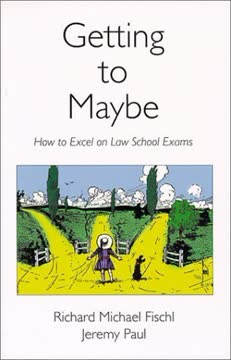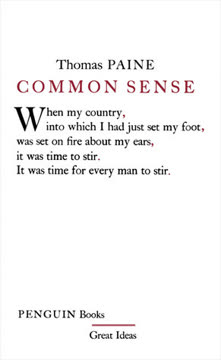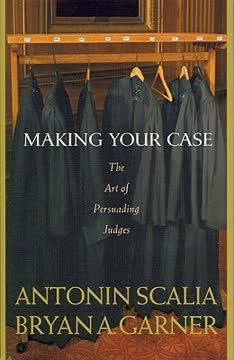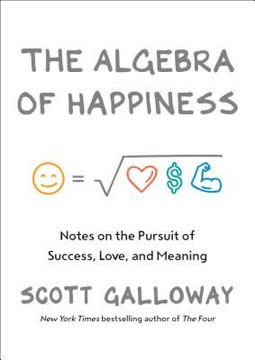Key Takeaways
1. Navigating Legal Ambiguity: The Essence of Law School Exams
In point of fact, you do need to "know the material"—the seemingly endless collection of cases, rules, policies, and theories examined in each of your courses — in order to excel in law school. But the rub is that knowing the material is only a starting point, for the typical law exam doesn't simply test your ability to recall—or even to understand really well—the many things you learned from the course in question. Rather, the typical exam tests your ability to use the material you've learned and to apply it to problems you've never seen before.
Beyond Memorization. Law school exams differ significantly from undergraduate tests, which often emphasize rote memorization and recall. Instead, law exams challenge students to apply their knowledge to novel, complex fact patterns, demanding critical thinking and analytical skills. The ability to use legal principles to solve new problems is the key to excelling in law school.
The "Box of Problems." The exam question is analogous to an engineering student's box of materials: success depends not on reciting information but on creatively using the provided resources to construct a solution. This requires students to move beyond simply knowing the law to actively engaging with it. Students must learn to identify, analyze, and argue thoughtfully about ambiguities within the questions.
Embracing Ambiguity. The core skill tested in law school exams is the ability to navigate ambiguity. Students must learn to recognize, analyze, and exploit the uncertainties inherent in legal rules and factual scenarios. This involves identifying multiple interpretations, weighing competing arguments, and constructing persuasive legal positions.
2. Forks in the Law: Rule vs. Counter-Rule and Competing Interpretations
Like a "fork" you encounter in a real road, an issue presents you with a choice between two (and sometimes more) paths leading in different directions. But unlike a fork in a real road, exam forks are more like the divide in the Yellow-Brick Road, where the Scarecrow tells Dorothy she can go "both ways."
Rule vs. Counter-Rule. One common "fork in the law" involves a choice between two conflicting legal rules, each potentially applicable to the same situation. This often manifests as a conflict between traditional and modern rules, or between the laws of different jurisdictions. Recognizing these competing rules is crucial for identifying the central issue.
Competing Interpretations. Another type of "fork" arises when a single legal rule can be interpreted in multiple ways. This often involves a tension between the plain meaning of the rule and its underlying purpose, or between competing policy goals. Students must analyze these competing interpretations to determine the most appropriate application.
Navigating the Forks. Successfully navigating these "forks in the law" requires students to identify the competing rules or interpretations, analyze their potential impact on the outcome, and construct persuasive arguments for each side. This demonstrates a deep understanding of the law and the ability to apply it critically.
3. Forks in the Facts: How Legal Categories Shape Factual Disputes
Unlike ordinary conversation, legal disputes—like our debate over the meaning of "vehicle"—will often pair plaintiff and defendant arguing about things like whether Joe's Place is really an "Italian restaurant" or really a "diner."
The Power of Categories. Legal reasoning relies heavily on categories, which determine how laws apply to specific situations. Disputes often arise over whether a particular set of facts falls within a given legal category, leading to "forks in the facts." These forks require careful analysis of the facts and arguments for different categorizations.
Sources of Factual Ambiguity. Several factors contribute to factual ambiguity, including:
- Facts on both sides of the category: Some facts support one categorization, while others support an alternative.
- Differing standpoints: Different parties may interpret the same facts differently based on their perspectives.
- Differing time-frames: The same facts may appear different depending on the time frame considered.
Mastering Factual Analysis. To excel on exams, students must develop the ability to identify these sources of factual ambiguity, analyze the competing interpretations, and construct persuasive arguments for their preferred categorization.
4. Twin Forks: Mastering the Interplay of Law and Facts
In the end, our point is that you should avoid the trap that befalls many law students. Having discovered that the purpose of a rule may provide a way of interpreting it that is different from a mere application of plain meaning — and having decided that this is a pretty neat trick — they stop thinking and rely on the first purpose they see in the legislative history or through policy analysis.
Linked Forks. Exam questions often present multiple sources of ambiguity simultaneously, creating "twin forks." One common pattern involves a "fork in the law" (e.g., rule vs. counter-rule) that leads to a "fork in the facts" (e.g., whether the facts satisfy the requirements of the applicable rule). Recognizing these linked forks is crucial for a comprehensive analysis.
Reciprocal Forks. Another pattern involves a back-and-forth interplay between law and facts. Students may need to move between interpreting a legal rule and interpreting the facts, with each step informing the other. This requires a flexible and iterative approach to legal analysis.
Concurrent Forks. A third pattern involves a "fork in the facts" that determines which legal regime applies (e.g., whether a transaction is governed by the U.C.C. or the common law), creating a concurrent "fork in the law." Students must analyze both the factual categorization and the applicable legal rules.
5. Strategic Issue-Spotting: Connecting Coursework to Exam Performance
Like "knowing the material," the ability to "spot the issues" is crucial to a successful exam performance; but like knowing the material, issue-spotting is nowhere near enough.
Beyond the Rulebook. Effective issue-spotting requires more than just memorizing legal rules. Students must develop the ability to recognize the patterns of ambiguity that create legal issues, including rule vs. counter-rule conflicts, competing interpretations, and factual ambiguities.
Active Learning. To develop these skills, students should actively engage with the course material, focusing on:
- Identifying the underlying purposes of legal rules
- Recognizing the elements of legal doctrines
- Analyzing the facts of cases and hypotheticals
- Discussing the material with classmates
Tailoring Study Habits. Students should tailor their study habits to fit the specific demands of law school exams, moving beyond rote memorization to focus on critical analysis and argument construction. This involves connecting familiar study techniques to the kinds of performance your professors expect.
6. Crafting Persuasive Arguments: From Analysis to Advocacy
A central task of lawyering is to translate the facts, policies, equities, and values that support her client's case into the language of the law (e.g., "the landlord breached the warranty of habitability and therefore the tenant should be able to withhold her rent"), and you simply can't do this unless and until you develop a facility with the rules that form the basic rhetoric of legal argument.
Beyond Issue-Spotting. Identifying legal issues is only the first step in crafting a successful exam answer. Students must also develop the ability to analyze those issues, construct persuasive arguments for different resolutions, and support those arguments with legal reasoning and policy considerations.
From Analysis to Argument. The key to moving from analysis to argument is to provide reasons for choosing one interpretation or outcome over another. This involves:
- Identifying the underlying policies and values at stake
- Weighing the competing interests of the parties
- Considering the practical consequences of different resolutions
The Art of Persuasion. Effective legal argument requires more than just stating your position; it requires persuading the reader that your position is the most reasonable, just, and consistent with legal principles. This involves anticipating and addressing counterarguments, and presenting your case in a clear, concise, and compelling manner.
7. Policy Analysis: Becoming a Czar of the Legal Universe
A significant part of what law professors teach and test is designed to help you learn to cope with these kinds of questions.
Beyond Legal Rules. Policy analysis involves evaluating the broader social, economic, and ethical implications of legal rules and decisions. It requires students to consider the purposes behind the law, the potential consequences of different outcomes, and the values that should guide legal decision-making.
Dimensions of Policy Analysis:
- Shaping Society: How will the rule affect behavior and social outcomes?
- Administering Policy: How easy will the rule be to enforce and administer?
- Doing the Right Thing: Is the rule fair, just, and consistent with moral principles?
- Institutional Role: Is the rule appropriate for courts or legislatures to decide?
- Government Non-Interference: Does the rule unduly interfere with individual liberty?
The Czar's Perspective. By adopting the perspective of a "Czar of the Universe," students can learn to think critically about the law and to develop well-reasoned policy arguments that go beyond mere legal formalism.
8. Avoiding Common Exam Pitfalls: A Guide to Success
The point is not to memorize them; it is rather to learn how to use them in particular contexts.
Beyond Regurgitation. Avoid simply regurgitating legal rules and principles without applying them to the facts. Focus on analyzing the facts, identifying the relevant issues, and constructing persuasive arguments.
Beyond Repetition. Avoid merely repeating the facts of the question. Instead, use the facts to support your analysis and arguments, highlighting the key details that are relevant to the legal issues.
Beyond Conclusions. Avoid conclusory answers that simply state a result without explaining the reasoning behind it. Provide a clear and logical explanation of your thought process, supporting your conclusions with legal rules, policy considerations, and factual analysis.
Last updated:
FAQ
1. What is Getting to Maybe: How to Excel on Law School Exams by Richard Michael Fischl and Jeremy Paul about?
- Law exam focus: The book is a comprehensive guide for law students on how to excel in law school exams, emphasizing legal reasoning over rote memorization.
- Ambiguity and analysis: It explains that law exams are designed to test students’ ability to navigate ambiguity, spot issues, and construct arguments rather than simply recall rules.
- Bridging theory and practice: The authors provide insights into how professors design exams and what they expect, helping students align their preparation with actual grading criteria.
- Practical strategies: The book offers actionable advice on exam preparation, writing, and argumentation, making it a practical resource for law students.
2. Why should I read Getting to Maybe by Fischl and Paul for law school exam preparation?
- Beyond memorization: The book dispels the myth that memorizing rules is enough, showing that success depends on creative application and handling uncertainty.
- Unique exam insight: It reveals the thought process behind law school exams, helping students identify hidden policy issues and multiple dimensions of legal problems.
- Critical thinking development: The book encourages embracing doubt and paradox, teaching students to argue both sides and reach well-reasoned conclusions.
- Comprehensive resource: It covers everything from issue-spotting to argument construction and test-taking strategies, making it a one-stop guide for law students.
3. What are the key takeaways and core concepts from Getting to Maybe by Fischl and Paul?
- Forks in law and facts: The book introduces the concepts of "forks in the law" (competing legal rules or interpretations) and "forks in the facts" (ambiguous fact patterns), which are central to law exams.
- Arguing both sides: Mastery involves recognizing and presenting strong arguments for opposing positions, not just finding a single "right" answer.
- Policy reasoning: Students are taught to incorporate policy arguments, considering how different outcomes affect society, administration, and fairness.
- Exam strategy: The book emphasizes outlining, organizing answers, and tailoring responses to the professor’s expectations and the specific question asked.
4. How does Getting to Maybe define and use the concepts of "forks in the law" and "forks in the facts"?
- Forks in the law: These are points where the law offers competing rules or interpretations, such as traditional vs. modern rules or statutory vs. common law conflicts.
- Forks in the facts: These involve ambiguities in how facts are categorized or interpreted, affecting the application of legal rules.
- Twin forks: Many exam questions combine both types of forks, creating layered ambiguities that require nuanced analysis.
- Issue-spotting skill: Recognizing these forks is essential for identifying the real issues at stake in law school exams.
5. What is the "arguing both sides" method in Getting to Maybe and why is it important?
- Essential lawyering skill: The book identifies the ability to see and argue both sides of a legal issue as the most important skill developed in law school.
- Responsive argumentation: Students are taught to present the strongest arguments for each side and respond directly to opposing arguments.
- Avoiding simplistic answers: This method helps students avoid one-sided or conclusory answers, demonstrating nuanced understanding.
- Exam performance: Professors reward students who can thoughtfully engage with ambiguity and conflicting perspectives.
6. How does Getting to Maybe recommend law students spot issues and ambiguities on exams?
- Deep study of material: Students should know the course material well enough to recognize recurring patterns of ambiguity and issues emphasized in class.
- Use of classnotes and old exams: Reviewing class discussions and past exams helps identify the kinds of forks professors test repeatedly.
- Mapping party conflicts: Understanding the claims and interests of parties in a hypothetical uncovers underlying legal conflicts.
- Thorough analysis: Students are encouraged to look beyond the first obvious issue and argue the other side to uncover hidden forks.
7. What is the role of policy arguments in Getting to Maybe’s approach to law school exams?
- Central to persuasion: Policy arguments help explain why courts should choose one interpretation or rule over another, especially in ambiguous situations.
- Multiple dimensions: The book introduces perspectives such as SHAPING, ADMINISTERING, FAIRNESS, INSTITUTIONAL ROLE, and NON-INTERFERENCE for analyzing policy questions.
- Beyond explicit policy questions: Policy reasoning is relevant in all exam questions, not just those explicitly framed as policy debates.
- Complexity and depth: Effective answers combine various policy arguments to show a sophisticated understanding of the issues.
8. How does Getting to Maybe critique and expand on the IRAC method for law exam answers?
- IRAC limitations: The book argues that IRAC (Issue-Rule-Application-Conclusion) is too simplistic for the complexity of law school exams.
- Multiple issues and ambiguities: Law exams often require recognizing competing rules, interpretations, and factual ambiguities that IRAC’s linear approach can miss.
- Emphasis on analysis: Students should develop nuanced arguments for each fork, considering policy and competing perspectives, rather than just applying rules.
- Flexible structure: The book encourages a more dynamic and responsive approach to organizing exam answers.
9. What practical exam-taking strategies does Getting to Maybe by Fischl and Paul recommend?
- Prepare all semester: Consistent study, focusing on classnotes and creating personal outlines, is essential for mastering forks and issues.
- Practice with old exams: Reviewing past exams helps identify professors’ favored forks and issue patterns, improving recognition and response.
- Outline and roadmap answers: Begin answers by outlining the issues and planned analysis to guide the grader and organize thoughts.
- Time management: Allocate time according to question value, write concisely, and outline remaining points if time runs short.
10. What common mistakes does Getting to Maybe warn law students to avoid on exams?
- Regurgitating rules or facts: Simply repeating legal rules or facts without analysis fails to show understanding and wastes time.
- Ignoring the question: Writing about irrelevant topics or failing to answer the specific question asked can severely hurt grades.
- Bluffing or B.S.: Professors can spot evasions and will penalize irrelevant generalities or attempts to bluff.
- Overreliance on commercial aids: Depending too much on commercial outlines can mislead students about what professors actually test.
11. How does Getting to Maybe advise students to handle uncertainty and doubt in law exam answers?
- Embrace doubt as strength: The book encourages students to write down their doubts and conflicting arguments, showing awareness of complexity.
- Thoughtful conclusion: After presenting multiple perspectives, students should select the more persuasive outcome and explain their reasoning.
- Avoid conclusory answers: Simple yes/no answers without explanation are discouraged; detailed reasoning and anticipation of counterarguments are key.
- Demonstrate mastery: Acknowledging and analyzing uncertainty demonstrates a higher level of legal reasoning.
12. What are the best quotes from Getting to Maybe by Fischl and Paul, and what do they mean?
- "Knowledge is free for those who seek it..." — Emphasizes the value of active learning and seeking understanding beyond memorization.
- "Not knowing the 'right answer' is very different from having 'no answer.' And sometimes 'maybe' may be the best answer of all." — Highlights the book’s core message that law exams test reasoning through ambiguity, not just finding a single correct answer.
- "If you must choose between our advice and the specific instructions of the professor giving the exam, toss our book out the window every time." — Reminds students to always prioritize their professor’s guidance over general advice.
- "The law school exam is a topic worthy of academic interest." — Reflects the authors’ view that exam-taking involves complex legal reasoning deserving serious study.
Review Summary
Getting to Maybe receives mixed reviews from law students and prospective law students. Many find it helpful for understanding law school exam strategies, particularly the concept of "getting to maybe" by exploring multiple perspectives. However, some criticize its dense writing and use of unfamiliar legal examples. Readers appreciate the insights into legal analysis but disagree on when it's most beneficial to read - before law school, during first semester, or close to exams. Overall, opinions vary on its effectiveness, with some praising it as essential and others finding it obvious or unhelpful.
Similar Books
Download PDF
Download EPUB
.epub digital book format is ideal for reading ebooks on phones, tablets, and e-readers.









